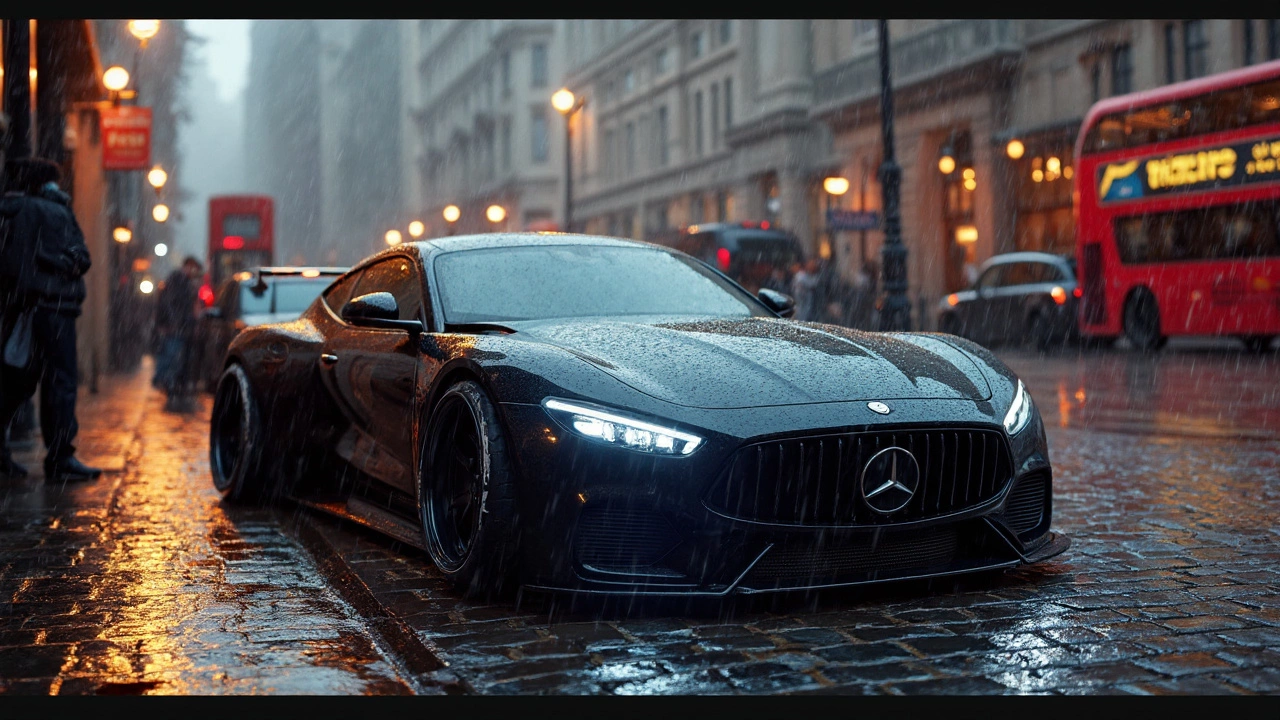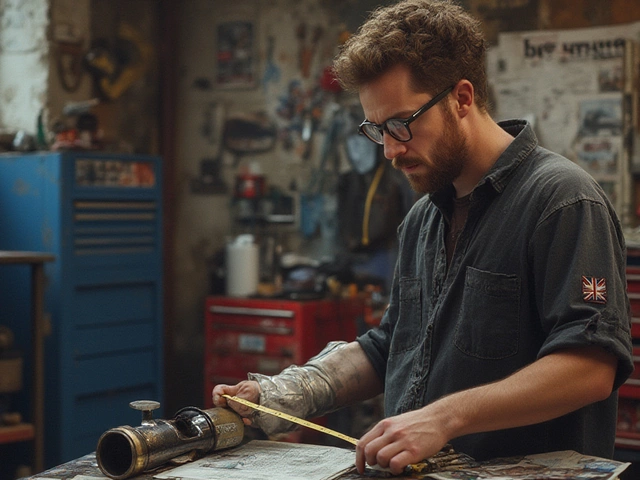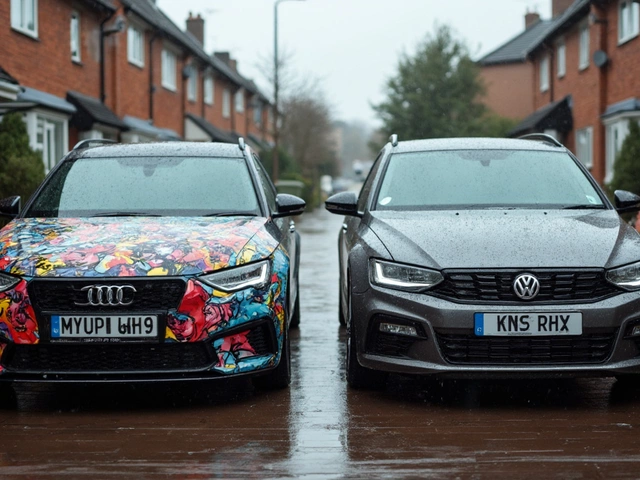Everyone sees a car body kit and thinks, 'Oh, that's just for show.' But there's way more going on. Body kits actually let you shape your car to fit your personality—or even turn some heads if that's your thing. But here’s what most folks don’t realize: a decent body kit can improve how your car drives and even save you cash on fuel.
Say you're sick of seeing the same boring models everywhere. A body kit gives you instant style points, making your car stand out in any parking lot. At the same time, some kits can help with airflow, which means you get a smoother drive and occasionally squeeze out better gas mileage. It's the kind of boost you actually feel, not just see.
If you’re thinking about resale, buyers definitely remember cars that look different (in a good way). Sometimes that extra flair translates to a higher selling price later on. So, picking the right body kit isn’t just about making your ride cool—it’s about giving it more value without a bunch of engine work or complicated upgrades.
- What Exactly Is a Car Body Kit?
- Style Upgrades You’ll Notice
- Aerodynamics: It’s Not Just About Looks
- Performance Perks and Surprises
- Resale Value and First Impressions
- Pro Tips for Choosing a Body Kit
What Exactly Is a Car Body Kit?
A car body kit is basically a set of parts that change how your car looks and sometimes how it drives. Most kits include things like front and rear bumpers, side skirts, spoilers, and different grilles. Instead of just swapping out one piece, you’re upgrading several all at once for a more complete style. These kits are designed to match up to specific car models, so you don't end up with parts that don’t fit right.
The real draw is that a car body kit gives you a custom look—your car doesn’t just fade into the crowd. They’re usually made from materials like fiberglass, polyurethane, ABS plastic, or carbon fiber. Here’s a quick breakdown of what usually comes in a kit:
- Front and rear bumpers: These set the tone for the car’s appearance.
- Side skirts: They give your car a lower, more aggressive stance.
- Spoilers or wings: Can help with high-speed stability.
- Fender flares or wide-body extensions: Good if you want a more muscular, track-inspired look.
Besides changing the way your ride looks, some kits are built with actual aerodynamics in mind. That means less drag, more downforce, and sometimes even better fuel economy if you drive a lot on the highway. But not all body kits are equal—some are for looks only, while others are tested for real improvements.
Curious what materials you’re dealing with? Here’s a quick table with how they compare:
| Material | Strength | Weight | Cost |
|---|---|---|---|
| Fiberglass | Medium | Light | Affordable |
| Polyurethane | Flexible/Strong | Moderate | Mid-range |
| ABS Plastic | Good | Moderate | Affordable |
| Carbon Fiber | Very Strong | Super Light | High |
It’s super important to go for a kit that’s made for your car model. Universal kits might seem easy to grab, but they usually don’t fit well and can be a headache to install. If you want everything to line up just right, stick with model-specific options. That way, you get the boost in style without weird gaps or extra work.
Style Upgrades You’ll Notice
If you want your car to turn heads, a car body kit is an easy win. It instantly changes the look, and the options are almost endless. You can go for a sportier bumper, wider fenders, unique side skirts, or even a spoiler that looks like it’s ready for the racetrack. Even something simple like a new front grille gives your ride more attitude.
Here are some of the most popular upgrades people choose with body kits:
- Bumpers: Want aggressive lines or smoother curves? Swapping the front or rear bumper does the trick.
- Side skirts: These clean up the side profile and can make your car look lower (without actually lowering it).
- Fender flares: Perfect if you run wider wheels or just want that muscular look.
- Spoilers and wings: Adds a race-inspired finish, even if you only drive on city streets.
- Diffusers: Finish off the rear in style and sometimes help airflow, too.
These upgrades aren’t just for sports cars. You see everyday sedans and hatchbacks rocking body kits all over car shows now. According to SEMA data from 2023, 28% of all aftermarket customizations in the US involved exterior body kits or parts. It’s not just about being flashy either—lots of people use them to fix minor scrapes or rust on older cars without expensive repairs.
| Upgrade Type | Common Effect | Typical Cost Range (USD) |
|---|---|---|
| Front/Rear Bumper | Modernizes look, aggressive style | $300–$1,200 |
| Side Skirts | Lowered appearance | $200–$700 |
| Fender Flares | Wider, more muscular stance | $100–$800 |
| Spoiler/Wing | Sporty finish | $100–$1,000 |
One thing to keep in mind: certain styles fit better with specific models. Always check what other owners have done and look for tried-and-true kits. That way, your upgrade won’t just look good—it’ll actually fit correctly without mods or headaches down the line.
Aerodynamics: It’s Not Just About Looks
Forget the idea that a car body kit is just for show—some kits genuinely change how your car slices through air. You’ve probably seen sports cars with low bumpers or side skirts; that’s not just for style. Car makers and aftermarket companies design these parts to reduce drag, so your car moves smoother and using less fuel.
Ever heard the term “downforce”? That’s what keeps your tires planted to the road at high speed. A well-built body kit (think lips, spoilers, and diffusers) manages airflow and gives better grip. You actually feel it if you drive quick on the highway or take tight corners—your car feels way more stable.
Even for daily drivers, small aerodynamics tweaks can help. For example, wind noise drops, and you might get an extra mile or two out of a full tank. Some tests show that a streamlined kit can boost gas mileage by 5% or more. Here’s a quick look at potential benefits from adding an aerodynamic body kit:
| Upgrade | Potential Benefit |
|---|---|
| Front Lip Spoiler | Reduces lift at high speed, improves handling |
| Side Skirts | Less air under the car, reduces drag |
| Rear Diffuser | Better airflow exit, more stability |
| Rear Wing/Spoiler | Creates downforce, improves grip |
But here’s the catch: not all kits are made equal. Some just look cool without doing anything real for airflow. Go for brands with wind tunnel testing or at least some proof of function. If you care about the science, always ask for data or check real-world reviews before you buy.

Performance Perks and Surprises
Most people slap on a body kit thinking it’s purely a style move, but performance upgrades are hiding in plain sight. Let’s start with something most car owners ignore: airflow. A well-designed car body kit can redirect air in smart ways—think splitters on the front bumper, side skirts, or a spoiler on the trunk. Not only does this cut down on drag, but some kits even add a little downforce. That means your car sticks to the road better at higher speeds, making highway driving feel steadier.
Lightweight materials are another game changer. Fiberglass and polyurethane are the big favorites because they shave off extra pounds compared to stock bumpers or panels. Less weight can mean faster acceleration and sharper handling. For instance, one test found that swapping out stock panels for lightweight kit parts dropped a Honda Civic’s weight by up to 30 pounds—a real difference you can feel if you push your car.
If you’re the DIY type or hit the track on weekends, you’ll want to know numbers. Here’s a quick peek at how some upgrades translate into actual gains:
| Body Kit Upgrade | Potential Performance Impact |
|---|---|
| Front splitter | Reduces lift by up to 20% at high speed |
| Side skirts | Smoother airflow – helps with stability above 60 mph |
| Rear diffuser | Improves downforce, makes rear end more planted |
| Spoiler/wing | Extra grip in turns, especially above 70 mph |
Here’s another surprise: some body kits can help keep your brakes and engine cooler. Vented or scooped bumpers pull in more air, helping prevent overheating when you’re driving hard. If you’re shopping for a kit, check if the designs channel air toward the brakes or engine bay—little things like this matter more than you’d think.
So, while it’s not magic, a solid kit can make daily driving better, sharpen up your weekend track days, and add real function to your car’s new look. Just keep in mind, not all kits are made equal—cheap, badly-fitting ones might look the part but mess with handling, or even make things worse. Go after kits tested for your exact make and model for the best results.
Resale Value and First Impressions
If you’re thinking about selling your car down the road, a body kit can be a secret weapon. It’s usually the first thing a potential buyer notices — and let's be honest, people do judge a car by its cover. A sharp-looking exterior with a quality car body kit can instantly set your ride apart from similar models, which can bump up your asking price.
According to Kelley Blue Book, cars with popular body mods can sell for up to 10% more than plain versions, as long as the work is tidy and fits the model’s vibe. But beware: going too wild with the kit or picking a style that’s not widely liked might hurt your chances when it's time to sell, especially if the next owner doesn’t want to stand out as much as you do.
- Choose a kit that matches your car’s age and class. A subtle lip kit suits a family sedan, while a sportier wide body fits a performance coupe.
- Stick to good brands — buyers do notice cheap or poor-fitting kits and it drags down the value.
- If you’re keeping the old bumpers and skirts, offer them to the next owner. Original parts can make your car more appealing.
- Keep all paperwork from the kit’s install. This helps prove that the work was done right and not just slapped on at home.
First impressions aren’t just about looks. Buyers figure that a well-kept, kitted car means you’ve probably cared for the rest of it too. That feeling of quality bumps up trust, which makes your ride stand out even more.
| Factor | Impact on Resale |
|---|---|
| Brand-name body kit | +5% to +10% value increase |
| Odd or flashy styling | Potential value drop |
| Clean install with receipts | Faster sell and higher trust |
| Keeping original parts | Added value to buyer |
A great kit doesn’t just help your car get noticed — it can put extra cash in your pocket when it’s time to move on. Just pick wisely, be practical, and keep things clean and documented.
Pro Tips for Choosing a Body Kit
Picking the right car body kit isn’t just a matter of matching colors. There are some real details you need to think about before you spend cash and risk ending up with a ride that looks weird or wrecks your gas mileage.
- Material matters. Fiberglass is light and cheap, but it can crack pretty easily if you hit a curb. Polyurethane is flexible and takes a beating; it’s great for daily drivers. ABS plastic is tough and usually fits better, but it costs more. If you’re aiming for serious racing, carbon fiber is king—just be ready for sticker shock because it’s expensive.
- Fit and compatibility. Make sure the kit is made for your exact make, model, and year. Universal kits are tempting, but they almost always need custom work that adds to the real price.
- Legal and safety issues. Some body kits drop your car lower, which can mess with regulations where you live, especially around bumper height or ground clearance. Double-check local laws before you order anything.
- Install it right. You can try a home project, but if you’re not handy, leaving it to a pro saves you from rattles, loose panels, or even safety issues. A pro knows how to line things up and seal everything tight.
- Paint and finish need attention. Most kits come unpainted. That glossy finish isn’t just for looks—it protects the kit and stops the sun or grit from wrecking it later.
Want some numbers? Here’s a no-nonsense look at what you might pay for different body kit materials:
| Material | Average Kit Price (USD) | Durability |
|---|---|---|
| Fiberglass | $500 - $1200 | Low to Moderate |
| Polyurethane | $1000 - $2000 | High |
| ABS Plastic | $1200 - $2500 | High |
| Carbon Fiber | $2000 - $5000+ | Very High |
It’s smart to budget for installation and paint in addition to the kit itself—labor can run $500 to $2000 depending on your car and who’s doing the work. If you’re looking for resale value or just want your car to last, don’t cheap out on fitting or paint jobs. The right pick means you actually get all those style and performance perks without any nasty surprises.




